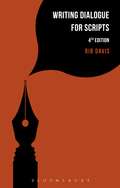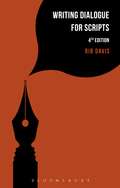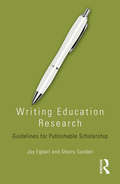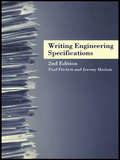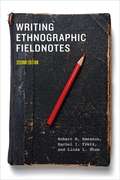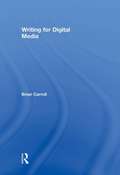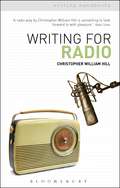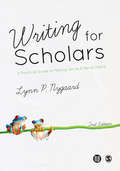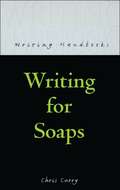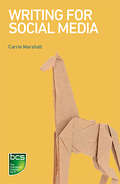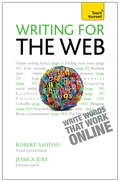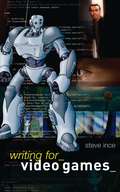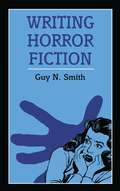- Table View
- List View
Writing Dialogue for Scripts (Writing Handbooks)
by Rib DavisA good story can easily be ruined by bad dialogue. Now in its 4th edition, Rib Davis's bestselling Writing Dialogue for Scripts provides expert insight into how dialogue works, what to look out for in everyday speech and how to use dialogue effectively in scripts. Examining practical examples from film, TV, theatre and radio, this book will help aspiring and professional writers alike perfect their skills. The 4th edition of Writing Dialogue for Scripts includes: a look at recent films, such as American Hustle and Blue Jasmine; TV shows such as Mad Men and Peaky Blinders; and the award winning play, Ruined. Extended material on use of narration within scripts (for example in Peep Show) and dialogue in verbatim scripts (Alecky Blythe's London Road) also features.
Writing Dialogue for Scripts (Writing Handbooks)
by Rib DavisA good story can easily be ruined by bad dialogue. Now in its 4th edition, Rib Davis's bestselling Writing Dialogue for Scripts provides expert insight into how dialogue works, what to look out for in everyday speech and how to use dialogue effectively in scripts. Examining practical examples from film, TV, theatre and radio, this book will help aspiring and professional writers alike perfect their skills. The 4th edition of Writing Dialogue for Scripts includes: a look at recent films, such as American Hustle and Blue Jasmine; TV shows such as Mad Men and Peaky Blinders; and the award winning play, Ruined. Extended material on use of narration within scripts (for example in Peep Show) and dialogue in verbatim scripts (Alecky Blythe's London Road) also features.
Writing Education Research: Guidelines for Publishable Scholarship
by Joy Egbert Sherry SandenFor both new academics and those with some experience, writing articles of publishable quality can be particularly challenging. Developing the necessary skill set requires useful information, hard work, and the type of direction infrequently offered in research methods courses, leaving researchers to piece together resources on their own. This book addresses this critical topic in a format that is easy to teach and understand. It is a practical volume that teaches researchers how to identify their audience, clearly state the nature of their work, provide exceptional literature reviews, cite appropriately, and explicate their research. Beginning each chapter with reviewer comments, Writing Education Research is designed to help scholars understand both how to write effective research reports and how to get published. Practice exercises and resource lists in each chapter offer easy-to-access information about the review and publication process. A perfect accompaniment to standard research courses, this practical book demystifies the writing process for anyone looking to publish articles, chapters, or papers in education.
Writing Education Research: Guidelines for Publishable Scholarship
by Joy Egbert Sherry SandenFor both new academics and those with some experience, writing articles of publishable quality can be particularly challenging. Developing the necessary skill set requires useful information, hard work, and the type of direction infrequently offered in research methods courses, leaving researchers to piece together resources on their own. This book addresses this critical topic in a format that is easy to teach and understand. It is a practical volume that teaches researchers how to identify their audience, clearly state the nature of their work, provide exceptional literature reviews, cite appropriately, and explicate their research. Beginning each chapter with reviewer comments, Writing Education Research is designed to help scholars understand both how to write effective research reports and how to get published. Practice exercises and resource lists in each chapter offer easy-to-access information about the review and publication process. A perfect accompaniment to standard research courses, this practical book demystifies the writing process for anyone looking to publish articles, chapters, or papers in education.
Writing Engineering Specifications
by Paul Fitchett Jeremy HaslamEngineers need to understand the legal and commercial context in which they draw up technical specifications. This thoroughly up-dated edition of Haslam's successful Writing Engineering Specifications provides a concise guide to technical specifications and leads the reader through the process of writing these instructions, with clear advice to help the student and professional avoid legal disputes or the confusion and time wasting caused by poor drafting. Designers and project managers should find this invaluable, and it should be helpful to insurers, lawyers, estimators and the like.
Writing Engineering Specifications
by Paul Fitchett Jeremy HaslamEngineers need to understand the legal and commercial context in which they draw up technical specifications. This thoroughly up-dated edition of Haslam's successful Writing Engineering Specifications provides a concise guide to technical specifications and leads the reader through the process of writing these instructions, with clear advice to help the student and professional avoid legal disputes or the confusion and time wasting caused by poor drafting. Designers and project managers should find this invaluable, and it should be helpful to insurers, lawyers, estimators and the like.
Writing Ethnographic Fieldnotes, Second Edition (Chicago Guides to Writing, Editing, and Publishing)
by Robert M. Emerson Rachel I. Fretz Linda L. ShawIn Writing Ethnographic Fieldnotes, Robert M. Emerson, Rachel I. Fretz, and Linda L. Shaw present a series of guidelines, suggestions, and practical advice for creating useful fieldnotes in a variety of settings, demystifying a process that is often assumed to be intuitive and impossible to teach. Using actual unfinished notes as examples, the authors illustrate options for composing, reviewing, and working fieldnotes into finished texts. They discuss different organizational and descriptive strategies and show how transforming direct observations into vivid descriptions results not simply from good memory but from learning to envision scenes as written. A good ethnographer, they demonstrate, must learn to remember dialogue and movement like an actor, to see colors and shapes like a painter, and to sense moods and rhythms like a poet. This new edition reflects the extensive feedback the authors have received from students and instructors since the first edition was published in 1995. As a result, they have updated the race, class, and gender section, created new sections on coding programs and revising first drafts, and provided new examples of working notes. An essential tool for budding social scientists, the second edition of Writing Ethnographic Fieldnotes will be invaluable for a new generation of researchers entering the field.
Writing Ethnographic Fieldnotes, Second Edition (Chicago Guides to Writing, Editing, and Publishing)
by Robert M. Emerson Rachel I. Fretz Linda L. ShawIn Writing Ethnographic Fieldnotes, Robert M. Emerson, Rachel I. Fretz, and Linda L. Shaw present a series of guidelines, suggestions, and practical advice for creating useful fieldnotes in a variety of settings, demystifying a process that is often assumed to be intuitive and impossible to teach. Using actual unfinished notes as examples, the authors illustrate options for composing, reviewing, and working fieldnotes into finished texts. They discuss different organizational and descriptive strategies and show how transforming direct observations into vivid descriptions results not simply from good memory but from learning to envision scenes as written. A good ethnographer, they demonstrate, must learn to remember dialogue and movement like an actor, to see colors and shapes like a painter, and to sense moods and rhythms like a poet. This new edition reflects the extensive feedback the authors have received from students and instructors since the first edition was published in 1995. As a result, they have updated the race, class, and gender section, created new sections on coding programs and revising first drafts, and provided new examples of working notes. An essential tool for budding social scientists, the second edition of Writing Ethnographic Fieldnotes will be invaluable for a new generation of researchers entering the field.
Writing Ethnographic Fieldnotes, Second Edition (Chicago Guides to Writing, Editing, and Publishing)
by Robert M. Emerson Rachel I. Fretz Linda L. ShawIn Writing Ethnographic Fieldnotes, Robert M. Emerson, Rachel I. Fretz, and Linda L. Shaw present a series of guidelines, suggestions, and practical advice for creating useful fieldnotes in a variety of settings, demystifying a process that is often assumed to be intuitive and impossible to teach. Using actual unfinished notes as examples, the authors illustrate options for composing, reviewing, and working fieldnotes into finished texts. They discuss different organizational and descriptive strategies and show how transforming direct observations into vivid descriptions results not simply from good memory but from learning to envision scenes as written. A good ethnographer, they demonstrate, must learn to remember dialogue and movement like an actor, to see colors and shapes like a painter, and to sense moods and rhythms like a poet. This new edition reflects the extensive feedback the authors have received from students and instructors since the first edition was published in 1995. As a result, they have updated the race, class, and gender section, created new sections on coding programs and revising first drafts, and provided new examples of working notes. An essential tool for budding social scientists, the second edition of Writing Ethnographic Fieldnotes will be invaluable for a new generation of researchers entering the field.
Writing Ethnographic Fieldnotes, Second Edition (Chicago Guides to Writing, Editing, and Publishing)
by Robert M. Emerson Rachel I. Fretz Linda L. ShawIn Writing Ethnographic Fieldnotes, Robert M. Emerson, Rachel I. Fretz, and Linda L. Shaw present a series of guidelines, suggestions, and practical advice for creating useful fieldnotes in a variety of settings, demystifying a process that is often assumed to be intuitive and impossible to teach. Using actual unfinished notes as examples, the authors illustrate options for composing, reviewing, and working fieldnotes into finished texts. They discuss different organizational and descriptive strategies and show how transforming direct observations into vivid descriptions results not simply from good memory but from learning to envision scenes as written. A good ethnographer, they demonstrate, must learn to remember dialogue and movement like an actor, to see colors and shapes like a painter, and to sense moods and rhythms like a poet. This new edition reflects the extensive feedback the authors have received from students and instructors since the first edition was published in 1995. As a result, they have updated the race, class, and gender section, created new sections on coding programs and revising first drafts, and provided new examples of working notes. An essential tool for budding social scientists, the second edition of Writing Ethnographic Fieldnotes will be invaluable for a new generation of researchers entering the field.
Writing for Digital Media
by Brian CarrollThis work teaches students how to write effectively for online audiences while providing them with a solid understanding of the ways that the Internet has blurred traditional roles of media producer, consumer, publisher, and reader. 9780415992015 9780203894316
Writing for Digital Media (PDF)
by Brian CarrollThis work teaches students how to write effectively for online audiences while providing them with a solid understanding of the ways that the Internet has blurred traditional roles of media producer, consumer, publisher, and reader. 9780415992015 9780203894316
Writing for Radio (Writing Handbooks)
by Christopher William HillWriting for Radio is an entertaining, accessible and informative book, providing a step-by-step guide to writing for this specific dramatic medium. A helpful approach to the process of writing a successful radio play from first draft to production draft and on into the recording studio, this book is suitable for first time writers, as well as established writers who simply haven't yet written for radio. A practical handbook that's both reliable and upbeat, providing an honest 'insider's view' of how radio plays are written and recorded.
Writing for Radio (Writing Handbooks #47)
by Christopher William HillWriting for Radio is an entertaining, accessible and informative book, providing a step-by-step guide to writing for this specific dramatic medium. A helpful approach to the process of writing a successful radio play from first draft to production draft and on into the recording studio, this book is suitable for first time writers, as well as established writers who simply haven't yet written for radio. A practical handbook that's both reliable and upbeat, providing an honest 'insider's view' of how radio plays are written and recorded.
Writing for Scholars: A Practical Guide to Making Sense & Being Heard
by Lynn NygaardLecturers request your electronic inspection copy here. Academics are not just researchers, but writers too. Using her many years of practical experience gained as a teacher and editor, Lynn Nygaard guides you through the whole process of writing and presenting your research in order to help you make your voice heard within the academic community. Grounded in real world advice rather than abstract best practice, Nygaard demonstrates a number of approaches to writing in order to help you identify those most suited to your own project. This updated new edition includes: Revised and expanded sections in each chapter More focus on the social sciences A more international focus Updated discussions on publishing practices Annotated biographies for each chapter New illustrations and images Additional practical tips and exercises From defining your audience, to forming your argument and structuring your work, this book will enable you to communicate your research passionately and professionally. Lynn Nygaard is Special Adviser on Project Development and Publications at the Peace Research Institute Oslo (PRIO). Companion Website study.sagepub.com/nygaardwritingforscholars Visit the companion website for additional online resources! This updated new edition includes: Revised and expanded sections in each chapter More focus on the social sciences A more international focus Updated discussions on publishing practices Annotated bibliographies for each chapter New illustrations and images Additional practical tips and exercises From defining your audience, to forming your argument and structuring your work, this book will enable you to communicate your research passionately and professionally.
Writing for Scholars: A Practical Guide to Making Sense & Being Heard (PDF)
by Lynn NygaardLecturers request your electronic inspection copy here. Academics are not just researchers, but writers too. Using her many years of practical experience gained as a teacher and editor, Lynn Nygaard guides you through the whole process of writing and presenting your research in order to help you make your voice heard within the academic community. Grounded in real world advice rather than abstract best practice, Nygaard demonstrates a number of approaches to writing in order to help you identify those most suited to your own project. This updated new edition includes: Revised and expanded sections in each chapter More focus on the social sciences A more international focus Updated discussions on publishing practices Annotated biographies for each chapter New illustrations and images Additional practical tips and exercises From defining your audience, to forming your argument and structuring your work, this book will enable you to communicate your research passionately and professionally. Lynn Nygaard is Special Adviser on Project Development and Publications at the Peace Research Institute Oslo (PRIO). Companion Website study.sagepub.com/nygaardwritingforscholars Visit the companion website for additional online resources! This updated new edition includes: Revised and expanded sections in each chapter More focus on the social sciences A more international focus Updated discussions on publishing practices Annotated bibliographies for each chapter New illustrations and images Additional practical tips and exercises From defining your audience, to forming your argument and structuring your work, this book will enable you to communicate your research passionately and professionally.
Writing for Soaps (Writing Handbooks)
by Chris CurrySoap opera has become the most popular form of radio and television drama and now constitutes the biggest market for modern day dramatists. For the new writer, as well as those experienced in other genres, this book reveals how Soap works. As well as covering the specifics of Soap writing, Chris Curry guides the writer through the uniquely collaborative process from storylining to finished script.'A clear, honest, practical and funny guide to soap writing' - Valerie Windsor.
Writing for Soaps (Writing Handbooks #49)
by Chris CurrySoap opera has become the most popular form of radio and television drama and now constitutes the biggest market for modern day dramatists. For the new writer, as well as those experienced in other genres, this book reveals how Soap works. As well as covering the specifics of Soap writing, Chris Curry guides the writer through the uniquely collaborative process from storylining to finished script.'A clear, honest, practical and funny guide to soap writing' - Valerie Windsor.
Writing for Social Media
by Carrie MarshallEngaging with customers through social media is essential for businesses in this day and age. Writing for social media can be difficult to get right and even big brands can get it very wrong. This book walks you through how to deliver maximum benefit for your business through your social media writing. Topics include how to develop an online persona, how to tailor your messages across different social media platforms, how to appeal to your audience, and how to use social media tools.
Writing for Social Media: Business And Technical Writing Series
by Carrie MarshallEngaging with customers through social media is essential for businesses in this day and age. Writing for social media can be difficult to get right and even big brands can get it very wrong. This book walks you through how to deliver maximum benefit for your business through your social media writing. Topics include how to develop an online persona, how to tailor your messages across different social media platforms, how to appeal to your audience, and how to use social media tools.
Writing for the Web: Teach Yourself Ebook (Teach Yourself)
by Robert Ashton Jessica JubyLike it or not, the internet has become integral to every aspect of our lives, with smart phones, tablet computers and wifi enabling us to communicate easily and instantly.Whether you're a rising star in the corporate world or a silver surfer, to make an impactonline you have to be able to write clearly, convincingly and in a way that emphasisesyour character too. Best-selling business author Robert Ashton and internet native JessJuby will help you communicate more objectively and effectively online, both at work andat home.
Writing For University
by Jeanne GodfreyThis concise, handy guide demystifies academic writing, providing students with real insight into writing well at university. Direct and practical advice allows students to gain the confidence, knowledge and tools to hit the ground running from their first year of study. Well-presented, featuring lively illustrations.
Writing for Video Games (Professional Media Practice)
by Steve InceVideo games is a lucrative new market for scriptwriters but writing for video games is complex and very different to traditional media (tv or film). This practical guide shows how you can adapt your writing skills to this exciting medium. Written by an award-winning games writer, the book gives you a realistic picture of how games companies work, how the writer fits into the development process, and the skills required: from storytelling, to developing interactive narrative, characters and viewpoints, dialogue comedy and professional practice. Illustrated with examples from games and quotes from developers, writers and agents, this is a cutting edge professional writing guide at a very accessible price.
Writing Horror Fiction (Writing Handbooks)
by Guy N. SmithThis writer's guide explains how to write short stories and horror fiction for children and adults. The author shows how to build on the initial idea and develop characters and plot. There are ideas for selecting and approaching publishers and information about contracts and publication.
Writing Horror Fiction (Writing Handbooks #51)
by Guy N. SmithThis writer's guide explains how to write short stories and horror fiction for children and adults. The author shows how to build on the initial idea and develop characters and plot. There are ideas for selecting and approaching publishers and information about contracts and publication.
